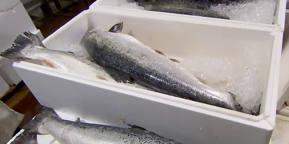Expanded Polystyrene
EPS Fishboxes
Light, strong, cool solutions for the fish supply chain
New web site reveals studies showing that polystyrene is a big fish in protecting Britain’s fishing industry
New Life Cycle and Thermal Tests reveal superior performance from EPS
The humble white expanded polystyrene (EPS) fish box is revealed as a significant contributor to food waste reduction, food safety and hygiene in protecting the 657,000 tonnes of fish landed at UK ports and fish farms every year. New studies reveal the outstanding protection credentials of EPS in preserving fish valued at £900 million p.a. on the journey to Britain’s supermarkets, fishmongers, restaurants and shops. “The polystyrene fish box deserves its place as the preferred solution for the protection of fish and shellfish. In fact, more than 22 million EPS fish boxes every year make an outstanding contribution to minimising waste in our valuable UK fishing and fish processing industry. They provide a simple, yet highly efficient, solution which keeps fish fresh and cool as well as protecting against physical impact. All of this is due to the outstanding performance of expanded polystyrene (EPS) as an insulator and impact protector. So we thought it was important to give this great packaging invention its own web site,” said David Emes, Chairman of the EPS Group of the British Plastics Federation.
UK producers of EPS fish boxes have come together to produce the web site following separate studies which reveal the life cycle advantages and thermal protection attributes of polystyrene in the fish and fish processing industry. The two new reports are featured on the site along with more details of the environmental credentials of EPS fish boxes.
“Thousands of tonnes of polystyrene are recycled every year in the UK.”
David Emes
Chairman, EPS Group
The independent cradle-to-grave LCA studies by Ecobilan tracked the journey of fish and shellfish for thousands of miles across three European markets. They compared the performance of three alternative fish box materials including polystyrene, waterproofed cardboard and corrugated polypropylene. The studies show that across these markets, in seven of the eight performance indicators, polystyrene was better than or at least comparable to the alternative materials. The full study can be viewed on the new web site.
In addition, the web site reveals new thermal performance studies carried out in the UK by Cool Logistics specifically to measure the critical food safety issue of temperature change during typical transits from port to fish counter. These also reveal the superior performance offered by EPS in maintaining the low temperatures essential in keeping fish and fish products safe on their way to our homes and restaurants. The tests, carried out under independent laboratory conditions, simulated the thermal protection offered by waterproofed corrugated carton board and twin-wall corrugated polypropylene compared with EPS. They give convincing evidence that EPS outperforms the alternative materials by providing safe temperatures for up to twice as long. The test results, for both large and small fish boxes, are published for the first time here.
David Emes concluded, “Over the years there have been suggestions that there might be a better packaging solution for fish but this new body of research shows that nothing compares to the long-established EPS solution. There are also concerns that EPS is not recyclable but thousands of tonnes of polystyrene are recycled every year in the UK. The only difficulty with fish boxes, whatever they are made of, is that the cleaning needed to remove fish residues and odour makes recycling non-viable in many cases. It is hoped in the future new technologies and opportunities will arise to resolve this,” said David Emes. “Meanwhile, we should accept that white polystyrene fish boxes are the best performer and best choice for a very tough task in protecting fish, preventing food waste and ensuring food safety through controlled temperature.”
-

Low Carbon Clean manufacturing technologies mean minimal energy and water inputs with no production waste
-

Economic Highly efficient manufacture and localised production units mean EPS is a low-cost, proven solution
-

Tough The 2% polystyrene cellular matrix gives outstanding impact resistance
-

Waterproof EPS is insoluble and non-hygroscopic
-

Natural Styrene for EPS is a byproduct of refining but is also abundant in natural products
-

Recyclable EPS packaging is easily recyclable where facilities exist
-

Lightweight EPS is effectively 98% air, minimising weight impacts in transportation
-

Hygienic & Safe EPS is non-toxic, chemically inert, and fungi and bacteria cannot grow on it
-

Insulating Unique insulation performance keeps fish safe and eradicates waste
Why use EPS?
EUMEPS
 EUMEPS is the association for European Manufacturers of Expanded Polystyrene. It represents converters of expandable polystyrene (EPS) to lobby and promote their interests in Europe. EUMEPS navigates the political and regulatory landscape in Europe and ensure that our voice is heard and the benefits of EPS as a construction and packaging material is understood.
EUMEPS is the association for European Manufacturers of Expanded Polystyrene. It represents converters of expandable polystyrene (EPS) to lobby and promote their interests in Europe. EUMEPS navigates the political and regulatory landscape in Europe and ensure that our voice is heard and the benefits of EPS as a construction and packaging material is understood.
EUMEPS’s vision as an association is simple: “To present a unified industry with a strong image and powerful voice”. This is done by providing a comprehensive service to all our members, allowing them to benefit from collective resources, knowledge and expertise in strategic areas of relevance to the industry.
Find out more here



 British Plastics Federation
British Plastics Federation